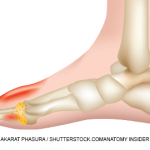Results
At month 0, the median SU was 8.6 (IQR 7.6–9.7) mg/dL. Seventy-one percent achieved an SU of <6 mg/dL by month 3, and this percentage increased slightly over time among retained participants. Gout flare rates were highest during nearly all intervals when SU ≥10 mg/dL and lowest when SU ≤3.9 mg/dL. Peak gout flare rates for all SU categories were observed between months 0 and 3, coinciding with the initiation of ULT and greatest change in SU. A second spike in gout flares occurred in all SU groups between months 6 and 12, coinciding with discontinuation of prophylaxis. In the initial year of ULT, flare rates did not significantly differ between SU groups, but flare rates were consistently highest when SU was ≥10 mg/dL. During months 12–72, in adjusted analyses with IPCW weights, a dose-response relationship was observed between SU category and flare rate. Compared with SU 4.0–5.9 mg/dL, significantly lower flare rates were observed when SU was ≤3.9 mg/dL and significantly greater rates when SU was ≥10 mg/dL (P for trend <0.01).
Conclusion
In short, when patients had a lower SU, their chances of flare decreased significantly. Clinicians may want to consider extending the length of time their patients remain on prophylaxis to minimize flares.
Editor’s note: For details and to review all figures, references and disclosures, refer to the full abstract.
Reference
- Tedeschi S, Hayashi K, Zhang Y, Choi H, Solomon D. Identifying optimal serum urate levels to reduce gout flares in patients taking urate lowering therapy: A post-hoc cohort analysis of CARES with consideration of drop-out [abstract]. Arthritis Rheumatol. 2023;75(suppl 9).



